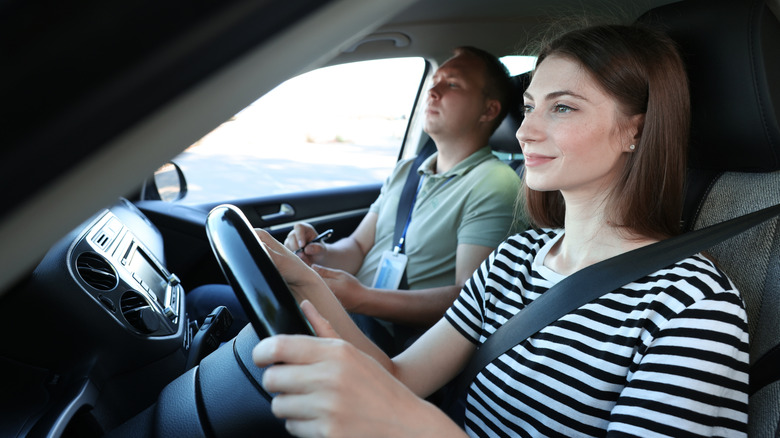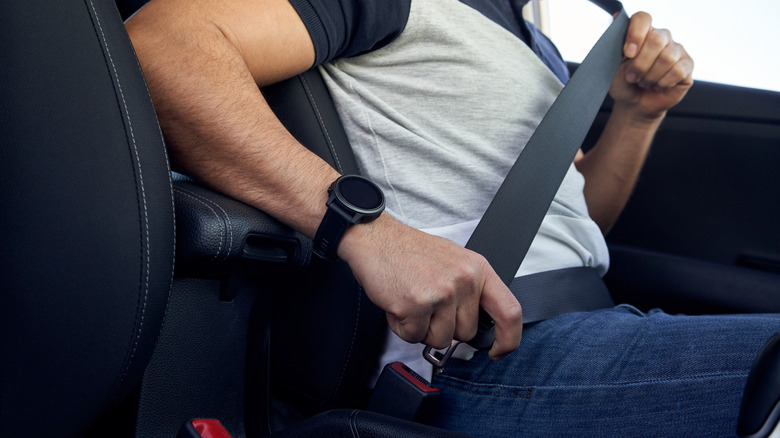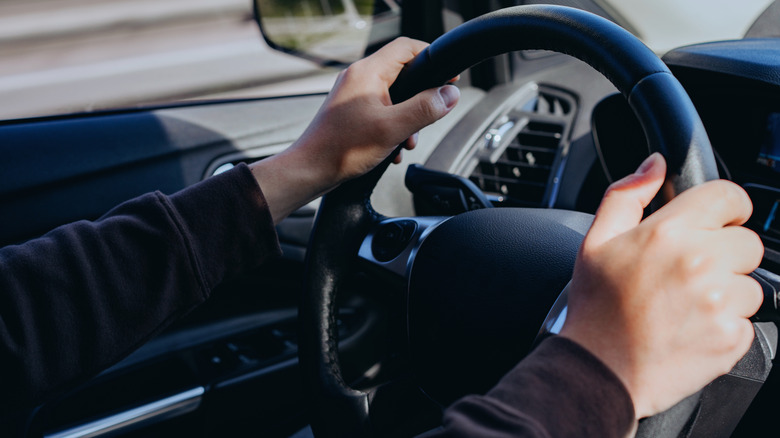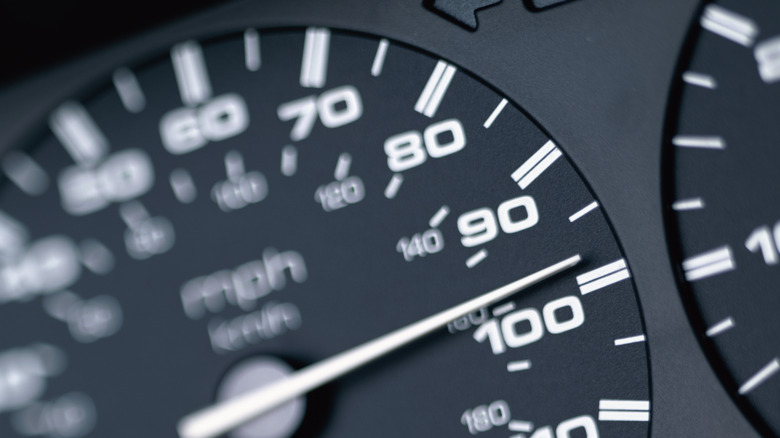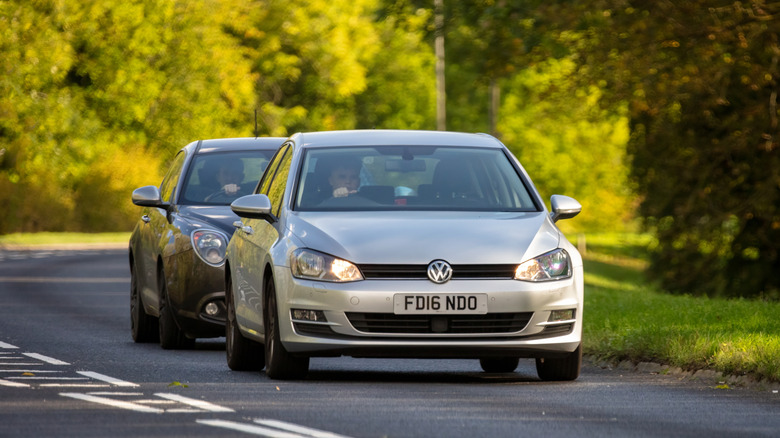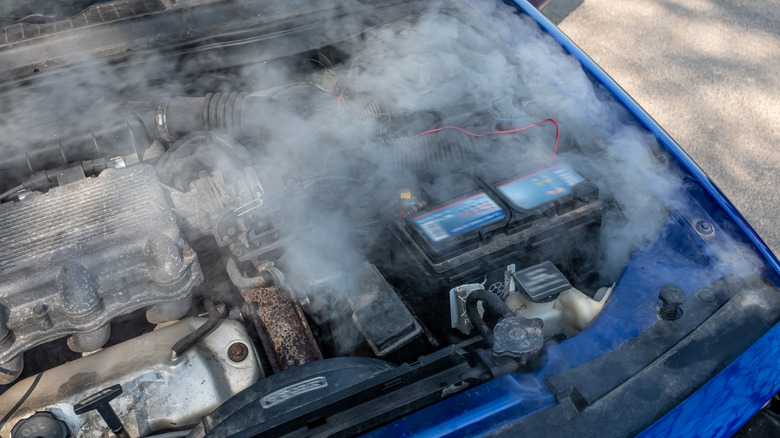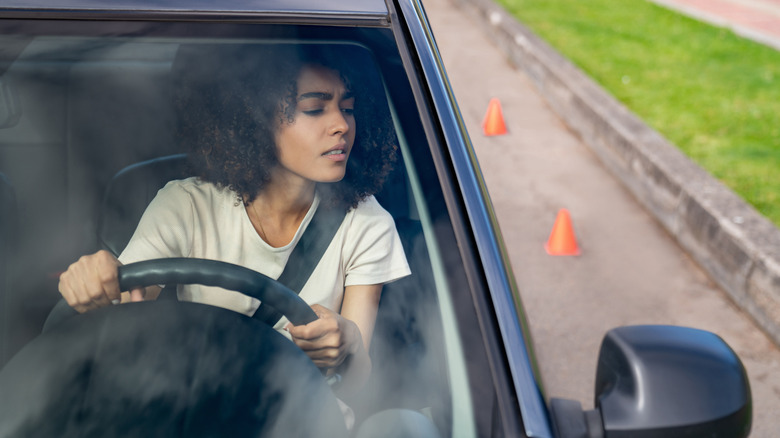10 Common Mistakes That Cause People To Fail Their Driving Test (And How To Avoid Them)
One of the most intimidating events you'll face in your life is getting your driver's license, and that's largely due to how nerve-wracking it can be to successfully complete a driving exam in front of a stranger whose job it is to scrutinize your every move.
The common advice of "don't be nervous" can feel a bit minimizing, especially when being so on edge could cause you to make mistakes you don't normally make. That's not to say that learning calming techniques, like meditation or deep breathing, won't help you on the day of your driving exam — they likely will. For something as technical as a driving test, getting consistent practice in trouble areas will help you out even more.
Thanks to the help of a wide variety of driver's education classes and instructors around the United States, including Northwest Driving School, Zutobi, and DriveSafe Colorado, I've compiled a list of the 10 most common mistakes you can make that may cause you to fail your driving test, along with helpful practice tips and tricks you can use to help avoid making these mistakes.
Not buckling your seatbelt
One of the most common driving test mistakes you can make is forgetting to buckle your seatbelt before you put the car in motion. While this is a simple step that only takes a few seconds, it's easy to forget when nerves are high, and unfortunately, failing to buckle your seatbelt before driving will result in an automatic fail.
It's important to prioritize buckling your seatbelt as soon as you get in the car to avoid forgetting to do it. As soon as you set down your belongings and close your car door, buckle that seatbelt. This means buckling your seatbelt before turning the car on, before choosing music for your drive, and even before checking your mirrors.
By practicing the habit, you'll be less likely to overlook buckling your seatbelt on the day of your driving exam. It'll become muscle memory, even on a day as stressful as your driving test.
Only driving with one hand on the wheel
Even if you see your parent driving with one hand on the wheel regularly or you think it makes you look more confident, driving examiners will always take points off if you don't have two hands on the steering wheel. In most cases, you won't automatically fail for making this mistake, but it's possible to lose too many points to pass by repeatedly making this error throughout your driving exam.
The recommended steering wheel hand placement used to be "10" and "2," referring to numbers on an analog clock, but the National Highway and Traffic Safety Administration (NHTSA) now recommends "9" and "3" as the best, safest option. This position puts your left and right hands halfway up the steering wheel, right across from one another.
If you find yourself regularly dropping one hand from the steering wheel while getting in practice hours before your exam, have your parent or guardian keep an eye out for this behavior and remind you immediately to put both hands back on the wheel.
Not coming to a complete stop
When you bring your car to a stop during your driving test, make sure you've stopped completely before beginning to drive again. Making a rolling stop at a stop sign can cause you to fail your driving test, and riding your brakes while waiting for a red light to change can get points deducted.
To ensure you don't accidentally perform a rolling stop during your driving test, practice counting to three or fully spelling out "STOP" in your head after fully pressing your foot down on the brake. Then, when test day comes, it'll be second nature to wait a few seconds after braking before you start driving again at a stop sign.
The only exception here is if the traffic light turns green before you have a chance to completely come to a stop. But if the traffic light is red as you're rolling up to it and you coast on your brakes, hoping it'll turn green before you have to stop, that'll likely get a few points deducted, more if it's a repeated mistake.
Coming to a complete stop is a good habit to get into, even past acing your driving test, as riding your brakes is a common driving habit that can damage your car in the long run.
Changing lanes without proper checks
During your driving test, the examiner will be paying attention to the steps you take prior to changing lanes, and failing to check your car's mirrors and blind spot before moving lanes will result in a failing score for that portion of the test. Similarly, changing lanes in an intersection will cause you to automatically fail.
Even though many modern cars feature sensors that help notify you when a car is in your blind spot, you can't rely on these in a driving test because you can't completely rely on them in regular driving. For this reason, you should get in the practice of manually checking your blind spot by physically turning your head in addition to checking your mirrors. Typically, the best order to follow is checking the rearview mirror, followed by the side mirror, and finally, the blind spot.
It's also important to remember to stay centered in your lane and flip on your left or right turn signal for at least five seconds before changing lanes to give other drivers plenty of time to predict your actions.
Not driving the legal speed limit
Most young drivers are aware that speeding on a driving test will cause them to lose points and possibly even fail, but many don't think the opposite is also true. Driving too slowly can actually cause you to fail your driving test as well since speeding can cause similar safety issues and risks for you and other drivers.
Speed limits are posted for a reason, so it's wise to stay as close to the speed limit as you can during your driving test. Additionally, stay aware of any special speed limit signs for nearby construction or active school zones.
Of course, it's possible you could encounter inclement weather on your driving test, like heavy rain or snow. In these cases, the driving instructor will pay attention to whether you're adjusting your speed accordingly to stay safe in rainy or snowy driving conditions. There's no clear-cut rule for how much you should slow down, as it depends on how bad the conditions are. If you're finding it difficult to judge for yourself, look at the speed of other drivers on the road as a starting point.
Braking abruptly
Driving instructors are paying attention to how well you control the vehicle, and this includes your ability to accurately judge the distance between your car and where you're trying to stop and brake appropriately. If you brake too quickly or too hard, you can lose points or even fail, depending on how abrupt the stop is.
There are two big tips that can help prevent braking abruptly. First, be aware of your surroundings. If you know there's a chance a car might jump out in front of you, slow down and negate the need to brake harshly to prevent a collision. Next, play around with different amounts of pressure on your car's brakes to see how touchy they are and how much force you'll need to exert to slowly and steadily come to a stop.
Learning to accurately gauge stopping distance is a driving habit that'll prevent you from spending more on gas, as braking too hard makes your engine work harder and ultimately guzzle down more fuel.
Following other drivers too closely
Even though many other drivers on the road fail to stick to this safety recommendation, the National Safety Council recommends that drivers keep a three-second distance between their car and the car ahead of them.
To roughly calculate this distance while driving, find a tree, street pole, or another object near the road and start counting to three seconds after the car in front of you passes that object. If you count to three or more before you reach the object, you're at a safe distance from the car in front of you. If you reach the object before you're done counting to three, you're following too closely, and could get points deducted from your score or even automatically fail, depending on how badly you're tailgating.
Past preparing for your driving test, following at a safe distance is a good habit to get into. Tailgating and aggressive driving are bad driving habits that can waste your money simply because these actions tend to put more strain on your engine and require more fuel in the long run.
Not understanding the rules of four-way stops
Understanding "right of way" is incredibly important prior to your driving test, and the most likely right-of-way assessment you may run into during your test is a four-way stop.
Especially for new drivers, four-way stops can be intimidating, but the rules are fairly simple and easy to remember. At a four-way stop or an intersection with flashing red traffic lights, the first car to arrive has right of way, followed by the second car that pulls up, then the third, and then the fourth. If you happen to drive up at the same time as another driver, the car that's on the left yields to the car on the right.
Even though these are the rules of four-way stops, you may run into the possibility that someone in another car waves you to go first despite them technically having right of way. If this happens, it's smarter to wave a thank you and take your turn rather than delay traffic by trying to convince the other driver to go first.
Failing to understand the rules of right of way on the road can lead to lost points, as your driving instructor may believe you lack enough knowledge to stay safe and aware behind the wheel.
Bringing a malfunctioning vehicle to your test
The vehicle you choose to bring to your driving test is important because if your vehicle breaks down or malfunctions during your exam, preventing you from successfully and safely completing the test, you'll automatically fail your driving test.
A few days before your driving test, take a look at the vehicle you'll be driving. Make sure your headlights and brake lights are working, check windshield wiper fluid, test out your wipers, and take care of any service light notifications just to be safe. If you have a lot of time before your driving test, take a look at these common maintenance mistakes that can make your car less reliable over time.
In addition to bringing a vehicle in good working condition to your test, you also need to bring current registration and insurance. If your registration is expired or your vehicle still needs to pass an inspection, you won't be allowed to take your test.
Failing to parallel park properly
Depending on your state, parallel parking may not be a requirement for your driving test. However, if your state requires you to parallel park in order to pass your exam, it's a skill you'll definitely need to practice. Some states, like Texas, require you to successfully parallel park to pass your driving test.
Parallel parking can be one of the trickiest driving skills to master, and even adults who have been driving for decades still struggle occasionally to maneuver a car into a spot. The steps to parallel parking sound relatively simple on paper, but in practice, it's quite difficult.
Generally, you need to turn your steering wheel fully to the right and start to reverse, align your wheels straight and continue to reverse, turn your steering wheel fully to the left and reverse, and finally, straighten your parking job. Try watching a few YouTube videos of the parallel parking process in action if you're more of a visual learner.
Once you've aced your driving test, it's time to start looking for your own car. To help you get started, here are some of the best used cars for new drivers to check out.
